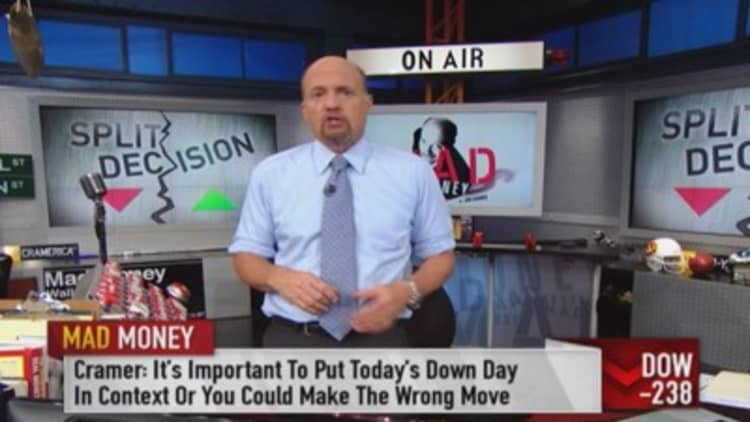
The next leg of this market isn't going to be easy. Cramer, however, has done this before. And he has a plan.
"Every correction is a process," Cramer said. And if you hope to survive a downswing with profits intact, Cramer believes it's critical to develop a strategy. "What I do is break stocks down into different groups," Cramer explained. Then he moves strategically.
Ground zero stocks
"First, you have ground zero, these are the companies most likely to have earnings shortfalls." In the current market, that may companies directly at risk due to a rapidly slowing global economy or declining commodity prices.
Cramer believes stocks in this category range from Ford, which lowered its forecast at a recent analyst meeting, to a string of industrial stocks, to commodity producers, as well.
Stocks in this category are most vulnerable.
"Although some stocks in this category have already fallen, others have not," Cramer said. Therefore, in this group, Cramer advocates making decisions on a case by case basis. "Cut back strategically," he said.
Periphery blast zone stocks
Cramer says the second group of stocks are on the periphery of the blast. Although negative catalysts may not impact them directly, these companies are also likely to cut estimates.
"These are multinational consumer companies like Kellogg or Coca Cola or Procter & Gamble, as well as big drug makers such as Abbott Labs and Merck. They are still going to sell a lot of goods but they will make less on them."
Cramer also said banks fall into this category, too, in part because many still trade at or near 52-week highs.
"Both banks and consumer stocks have been holding up well. But I think their numbers are too high. In turn, their stocks are too high."
Undamaged stocks
In the third group, Cramer said, "this is where opportunity lies." These are stocks that are not likely to cut estimates, but soldoff anyway due to a swell of negative sentiment in the market.
"Two good examples are retailers and restaurants," Cramer said. "I believe, in the end these companies' profits might be better than people think. Why? First, because gasoline is sliding below $3 in much of the country" and as Cramer so often says, lower prices at the pump leave more money in people's wallets.
"Second, Americans are less fearful of losing their jobs," which in turn could drive incremental spending.
Also in this group are companies that have nothing to do with the negatives in the market. They are secular growers such as Facebook or Apple. And finally, defense stocks also fall into this group, too; again because they are unlikely to cut estimates. "Given the international turmoil and the need to boost our defense budget," Cramer thinks they should remain relatively unscathed. "Think Lockheed Martin and Northrop Grumman," he said.
---------------------------------------------------------------
Read more from Mad Money with Jim Cramer
Cramer's Remix: Perilous landscape
Russell 2000 death cross, buy signal?
Don't fret about low oil, profit instead
---------------------------------------------------------------
Of course every selloff has unique qualities and the plan outlined above isn't written in stone. It does, however, provide an outline that could help you navigate the market if and when stocks decline further.
And if you're in cash already and looking to put money to work, "There is no hurry to buy," Cramer added. "At my charitable trust we are buying very small after selling industrials, including the oils, very big. I believe that everything, I repeat, everything is going down for now. No hurry."
Call Cramer: 1-800-743-CNBC
Questions for Cramer? madmoney@cnbc.com
Questions, comments, suggestions for the "Mad Money" website? madcap@cnbc.com



